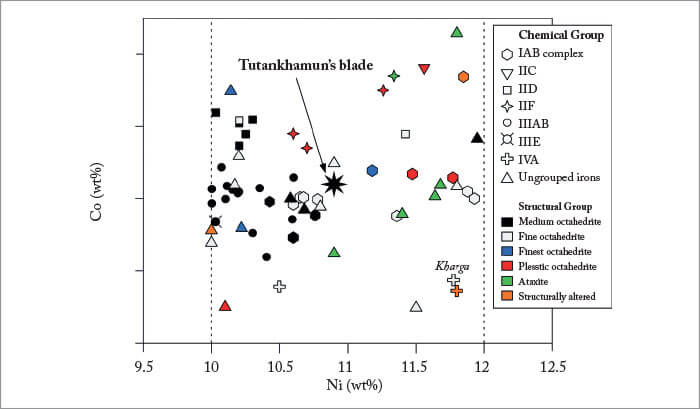Tutankhamun’s tomb and its contents have been the subject of fascination since its discovery by archaeologist Howard Carter in 1922. Results of previous analyses of Tutankhamun’s iron funerary objects have proved controversial, with scientists arguing over whether the high nickel content is suggestive of meteoritic origin. Most recently, a bilateral project between Italy and Egypt – focusing on the non-destructive analysis of objects from the ancient Egyptian culture – has allowed a multidisciplinary team to analyze one of two daggers found in the mummy’s wrapping. They have concluded that the dagger blade is in fact made of meteoritic iron.
The team analyzed the bulk composition of the blade using non-destructive x-ray fluorescence (XRF) spectrometry. “The chemical compositions of iron meteorites are typically determined by means of sensitive (but destructive) analytical methods, including instrumental neutron activation analysis and inductively coupled plasma mass spectrometry,” says Daniela Comelli, Researcher at the Polytechnic University of Milan, and an expert on the development and optimization of scientific non-destructive methods on cultural heritage objects. “By contrast, XRF spectrometry allows you to get information on the composition of an object (in terms of chemical elements) in a quick, easy and non-destructive way.” The composition of the metal of the dagger blade (iron, plus 10 wt% nickel and 0.58 wt% cobalt), is characteristic of nickel-rich iron meteorites, according to two of Comelli’s colleagues, planetary scientists Massimo D'Orazio and Luigi Folco (University of Pisa). In particular, the nickel-cobalt ratio is close to the cosmic ratio typically observed in meteorites.


The result has important implications. “This confirms that before the advent of The Iron Age, ancient Egyptians considered the rare pieces of meteoric metal a valuable source for the production of precious ornamental objects,” Comelli says. It also provides insight into the iron working capabilities at that time. “The high manufacturing quality of the dagger suggests that ancient people of the eastern Mediterranean area had acquired significant mastery in iron smithing already close to the end of the Bronze Age.” The idea for the research was originally conceived in 2010 by iron meteorite experts from Pisa University, who proposed analysis of Tutankhamun’s dagger but were unable to gain access. Though it is still too early to judge the response of the archaeological communities to the research, the team now hope the discovery will allow them to analyze the other iron objects in Tutankhamun’s tomb. Comelli is tentatively optimistic: “I hope our discovery reinvigorates interest in this kind of scientific research!”
References
- D Comelli et al, “The meteoric origin of Tutankhamun’s iron dagger blade”, Meteorit Planet Sci [online] (2016). DOI: 10.1111/maps.12664




